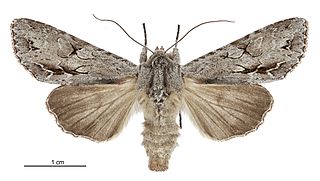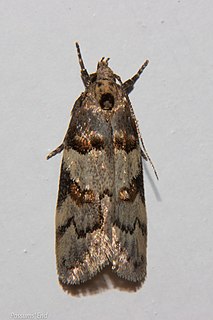
Tingena armigerella is a species of moth in the family Oecophoridae. T. armigerella is endemic to New Zealand where it is found in the North Island. The larvae of this species feed on plant litter. It is parasitised by the parasitic wasp Fustiserphus intrudens.

Ichneutica mutans, commonly known as the New Zealand cutworm or the grey-brown cutworm, is a moth of the family Noctuidae. This moth endemic to New Zealand and can be found throughout New Zealand, including from Three Kings Islands down to Stewart Island. However this species is not found in the Chatham Islands. The adult moths are on the wing all year round. I. mutans is variable in appearance and can be confused with similar species in the same genus. As a result of the variety of host species consumed by the larvae of the species, including such crops as turnips, wheat and apples, this species is regarded as an agricultural pest. However between the early 1960s and late 1980s the population of I. mutans was shown to have decreased significantly, by over 80%, at two study sites.

Ichneutica insignis is a moth of the family Noctuidae. It is endemic to New Zealand. This species is found throughout New Zealand, although it appears to be scarce in inland sites of tussock grasslands. The adults are on the wing throughout the year. It is a variable species and as such can be easily confused with I. skelloni and I. plena. The larvae of this species have been recorded as feeding on Trifolium pratense.

Ichneutica ustistriga is a moth of the family Noctuidae. It is endemic to New Zealand and can be found from the Three Kings Islands to Stewart Island. This species lives in a wide variety of habitats including domestic gardens, horticultural areas, orchards, native and exotic grasslands, as well as native forest. The larvae eat a variety of herbaceous plants. Recorded food plants include Muehlenbeckia australis, Muehlenbeckia complexa, Olearia hectorii, Plantago lanceolata, and Urtica australis. This moth has a mauvish grey wing colour and is unlikely to be confused with other species as the patterns on its forewing are distinctive. This species is on the wing throughout the year and is attracted to both sugar and light traps. Adult moths can be found at rest on fences and tree trunks during the day.

Batrachedra arenosella, the armoured scale eating caterpillar or the coconut moth, is a species of moth of the family Batrachedridae. It was first described by Francis Walker using specimens collected in Auckland, New Zealand. It has been hypothesised that the New Zealand moth may contain two distinct species. As well as the moth species in New Zealand, this name has been applied, perhaps incorrectly, to moths found in India, Indonesia, the Malay Peninsula, and Réunion, as well as in Australia, from the Northern Territory and northern Queensland to New South Wales and South Australia.

Izatha copiosella is a moth of the family Oecophoridae. It is endemic to New Zealand, where it is found on the south-eastern parts of the North Island and throughout the South Island except the West Coast. Larvae are found in dead wood and are likely to use kōwhai species as hosts. The adults are night fliers and are attracted to light. They are on the wing in January and February.

Heterocrossa adreptella is a moth of the Carposinidae family. This species was long considered the New Zealand raspberry budmoth however this was a taxonomic misinterpretation of the type material used to describe this species. This error was corrected in 1988 with the New Zealand raspberry budmoth giving its own species name Heterocrossa rubophaga. H. adreptella is endemic to New Zealand and has been collected in the Wellington Botanic Garden and been observed resting on mānuka branches.

Pterophorus innotatalis is a moth of the family Pterophoridae. It is endemic to New Zealand and has been found in the North, South and Ruapuke Islands. Adults of this species have been recorded as being on the wing from October to March as well as in August and prefers to inhabit grass or fern covered hills. The larvae are leaf miners and feed on Dichondra species, including Dichondra brevifolia and Dichondra repens.

Pyroderces apparitella is a species of moth in the family Cosmopterigidae. It is endemic to New Zealand and has been observed in the North Island where it is regarded by some as being not common. The preferred habitat of this species is native forests and residential gardens. Adults are on the wing in December and January and the species is attracted to light.

Pasiphila muscosata, the emerald pug moth, is a moth in the family Geometridae. It is endemic to New Zealand and has been found in the North, South and Stewart Islands. The larvae of this species are known to be present in January and live on Muehlenbeckia species including Muehlenbeckia australis. The larvae tends to be brown but it is variable in both colour and markings. The larvae of this species pupates in a loose cocoon on the ground and adult moths emerge in September. Adults are commonly on the wing until the following May. Although adults tend to be a deep emerald green colour this species is again variable and there is also an orange-yellow variety as well as intermediate forms. Adults are attracted to light and often rest during the day on tree trunks.

Homodotis megaspilata, also known as the small hooked-tip looper moth, is a moth of the family Geometridae. It is endemic to New Zealand and can be found throughout the country. It is regarded as being common species. The preferred habitat of this species is native forest, scrub, coastal areas and domestic gardens. Larvae feed on the dead leaves of Geniostoma ligustrifolium and likely other native plants. Once mature the larvae will pupate on the ground forming a silken cocoon protected by hiding inside two leaves of its host plant. Adults are nocturnal and are on the wing from October to April. They are attracted to light. In appearance the adults of this species are extremely variable but can be distinguished from similar species as all variations have forewings with blunt hook shaped tips.

Agriophara colligatella, also known as the Olearia Skeletoniser, is a moth of the family Depressariidae. It is endemic to New Zealand and is found on both the North and South Islands. This species inhabits native scrub. Larvae feed on the leaves of species in the genus Olearia during the months of November and December. They then pupate amongst the old flowers and leaves of their host plant. Adults have been observed on the wing from August to September but are most common in January. It has been hypothesised that this species overwinters as an adult as it has been observed on the wing in late autumn and early winter. Adults are attracted to light.

Eudonia sabulosella is a species of moth in the family Crambidae. This species is endemic to New Zealand and is regarded as being common. The larvae of this species are known to damage pasture in New Zealand.

Physetica temperata is a species of moth of the family Noctuidae. It is endemic to New Zealand and found in the North Island and the top of the South Island in coastal areas. P. temperata is unlikely to be confused with other species in its range, even though it is not distinctively patterned. It is possible that males might be confused with males of P. homoscia but this latter species is much larger. P. temperata can be distinguished from P. caerulea as the former species has forewing veins that are marked black and a chequered forewing fringe. The adults of this species are on the wing from September to March. The life history of this species has not been well documented although it is thought that larval host species is Ozothamnus leptophyllus.

Tingena apertella is a species of moth in the family Oecophoridae. It is endemic to New Zealand and can be found in both the North and South Islands. Adults are on the wing from November to January and the species is common in beech forests at approximately 2000 ft. At rest on the ground this species appears very similar to a yellow beech leaf.

Tingena contextella is a species of moth in the family Oecophoridae. It is endemic to New Zealand and has found in the North and South Islands. The larvae of this species feed on leaf litter.

Tingena innotella is a species of moth in the family Oecophoridae. It is endemic to New Zealand and is found in both the North and South Islands. This species inhabits open native forest or scrubland and adults are on the wing from December to March. T. innotella appears to have an affinity for the silver tree fern.

Tingena plagiatella is a species of moth in the family Oecophoridae. It is endemic to New Zealand and has been observed in both the North and South Islands. This species inhabits light native bush or scrubland. Adults of this species are on the wing from November to January.

Trachypepla conspicuella is a species of moth in the family Oecophoridae. It is endemic to New Zealand and is found in both the North and South Islands. It is similar in appearance to its close relative T. euryleucota but tends to be paler. Its colouration imitates bird droppings. Larvae feed on leaf litter. Adults of this species are on the wing from November to February and have been observed resting on fences and walls.

Trachypepla contritella, the Kiwi Enigma, is a species of moth in the family Oecophoridae. Originally endemic to New Zealand this species can be found throughout that country. However, from 2012 this species has been also been recorded in the United Kingdom. The preferred habitat of T. conritella is New Zealand native forest and larvae of this species are litter leaf feeders. Adults are on the wing from November to February in New Zealand and are attracted to light.





















